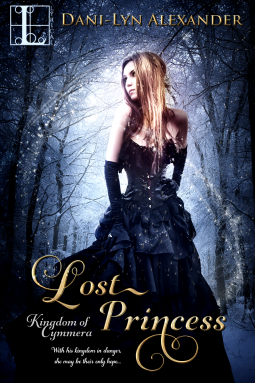
Dani-Lyn Alexander
Lyrical Press
Published: 10/13/15

Amazon | Barnes & Noble | Goodreads
Ryleigh’s boyfriend is from another dimension. Literally. Jackson, the newly crowned king of Cymmera wants her to leave the human world behind and join him in ruling his kingdom. Torn between what could be her destiny and her love for her younger sister still in the human world, Ryleigh isn’t sure what to do. Then an important Cymmeran relic disappears. Ryleigh sets out to find the missing stone and stumbles onto a treasonous plot that could destroy Jackson’s fragile kingdom. She must find a way to warn him before the betrayal can be carried out.
There’s an old writing saying about beginning a story in the middle. Alexander was paying attention. The very first chapter of The Lost Princess is jam-packed with action and conflict. I haven’t read the first book in the Kingdom of Cymmera series, so I was a little nervous about being able to follow the story. For the most part, though, it was easy to figure out what was going on and why it was significant.
Once the story shifts into the Cymmeran realm, the action stays high but the conflict becomes more organized. Jackson’s motivations are clear and powerful. And though Ryleigh gets herself into a bit of trouble, she’s far from a helpless maiden. Most of the story centers around these two characters. I found myself wishing for more information about Dakota, Jackson’s best friend, and Mia, Ryleigh’s little sister.
One thing that did slow the story down for me was the sheer number of adjectives in each sentence. Sometimes the descriptions heightened the emotional impact of a scene, but at other times it almost made moments seem cheesy or melodramatic. I think the story would have been stronger by tightening things up, especially in those intense moments.
Over all, this wasn’t my favorite. The things I liked about it – the strong heroine, worthy hero, fantasy landscape – can be found in other stories where the narrative is better executed. Readers looking for high action and fierce romantic tension may find this story to be a good fit, though, as Alexander delivers on both counts.
No profanity.
Sexual Content
Jackson tries his best to keep the smooching to a minimum. Prolonged kissing begins a ritual that will bind Ryleigh to him forever, and he wants to wait until she’s ready to make that choice. However, there’s a lot of sexual tension between the two. A lot of references to their feelings for each other via physical experiences – an aching need to be together, that sort of thing.
At one point, though, the kissing does get a bit carried away, and while the two are still clothed, they are lying down together and the imagery is pretty sexual.
Spiritual Content
Jackson and his people live in an alternate realm to the human world. Some of his people are part of a league called Death Dealers, who venture into the human world to kill certain targets and bring them back to their own kingdom to live. They use portals to travel from one place or dimension to another.
Elijah, a prophet has visions that he reveals to the Cymmeran leadership. They follow his directions. It’s unclear if this is supposed to be a supernatural gift or a religious experience for the prophet. The evil king has a prophet/sorcerer of his own as well. Ryleigh finds a spirit animal who remains at her side as a protector throughout the story.
Violence
Battle imagery. References to torture. A prisoner is pretty severely brutalized. A prince exacts revenge on an old enemy by stabbing him in the temple.
Drug Content
None.
Save
Save